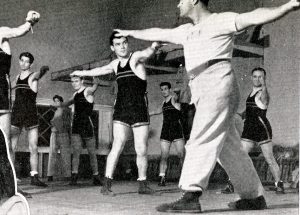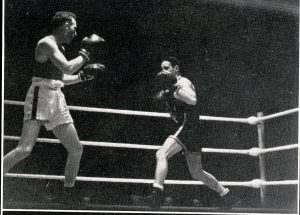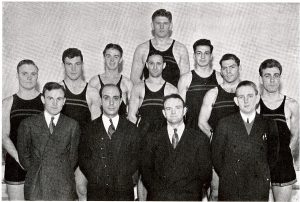
This week’s post was written by Dallas Grubbs, a graduate student in History.
More than four thousand people pack into the gym in what is now the Crough Center Architecture building. The gentleman are dressed in black tuxedos, the women in fine silk dresses. Murmurs of excitement fill the hall. These spectators have arrived more than two hours early to ensure their place at this most recent performance of “Eddie’s boys.” “Eddie’s boys,” by the way, are not an all-male a cappella group. They are, in fact, the fiercest boxers on the east coast.
The year is 1938. The decade has witnessed the rise of CUA’s “mittmen” to dominance under the tutelage of coach Edmund “Eddie” LaFond, who has guided his teams to almost forty wins in their last fifty bouts. These bouts, composed of three two-minute rounds, were undoubtedly the longest and most punishing six minutes in the lives of those lads who had to compete against “Eddie’s boys” in the packed arenas. Yet despite their successes, two goals continue to elude LaFond and his punishing pugilists. The first is an undefeated season. The second, an NCAA boxing championship. The year is 1938. And this year LaFond and his boys have decided that they’re going to have both.

The competition, however, is steep, and LaFond, a CUA alumnus (1927), founder of the college’s intercollegiate boxing program, and a ruthless competitor in his own right, knows the task will not be easy. While he has faith in all of his players, he has particularly high expectations for David “Davey” Bernstein, a scrappy 115-pound architecture student. Described by his peers as “a cocky, friendly, humorous little bird,” this stout sophomore differed from most creatures of the avian variety by sporting a walloping and rather unusual left hook. One report described it thus: “He starts the punch as if he were throwing a straight left jab, then hooks the punch into the jaw.”
This year, the “redbirds’” tough schedule will offer Bernstein and his fellow fisticuffers ample opportunities to demonstrate their toughest moves. The Cardinals must first square off against two rivals very close to their nest—Western Maryland and University of Maryland—with the latter offering “Eddie’s boys” their stiffest competition of the season (final score: 4 ½ to 3 ½ points). They then fly north, leaving a trail of destruction in their wake. Duke, Villanova, and Pittsburgh easily succumb to the merciless mitts of Bernstein and company, placing the team at 5-0 for the regular season. Eddie LaFond and his boys have clinched their much-desired perfect season. But they are still not satisfied. The true prize still awaits them in Charlottesville, Virginia, at the 1938 NCAA tournament.

Four members of the team—David Bernstein, Fred Stant, Jr., Jay Turner, and Leo Katalinas—have earned a trip to the finals. Two of them, Bernstein and Katalinas, will reach their respective championship rounds. The 220-pound heavyweight Katalinas goes down after a tough and grueling fight. All eyes are now on the 115-pound Davey Bernstein. Bernstein’s eyes, meanwhile, remain fixed on Sewele Whitney of Loyola, his opponent in the bantamweight finals.

The first two rounds of the Bernstein-Whitney bout are exceptionally uneventful. The two men size each other up, exchanging glancing blows. Thirty-five seconds into the third and final round, however, things begin to heat up. Whitney unleashes a series of well-placed blows while Bernstein remains focused, patient, waiting. At the perfect moment, he delivers his devastating left hook into his opponent’s jaw and then directs a series of hard rights toward other parts of Whitney’s cranium. One of the blows strikes Whitney above the right eye, drawing blood. The wound is of sufficient damage to prompt the referee to award Bernstein a technical knockout and, with it, the NCAA bantamweight championship. Bernstein later attributed his tournament triumph to the fact that he had “made fewer mistakes than Whitney that day.” Coach LaFond was proud of his boy for securing for CUA its first national boxing championship and used the opportunity to praise both the sport and the campus community. “Show me another sport,” he said, “where a 120-pounder can be a campus hero.”
David Bernstein went on to serve in the US Army Corps of Engineers during World War II before embarking on a successful career in architecture. He was inducted into the CUA Athletics Hall of Fame in 1980. LaFond continued to coach boxing for several years and went on to serve as the school’s Athletic Director. In 1939, only one year after coaching his team to an undefeated season and an NCAA championship, LaFond coached yet another player, Fred “Bingo” Stant, Jr., to an NCAA championship victory. But that, alas, is a tale for another day.
